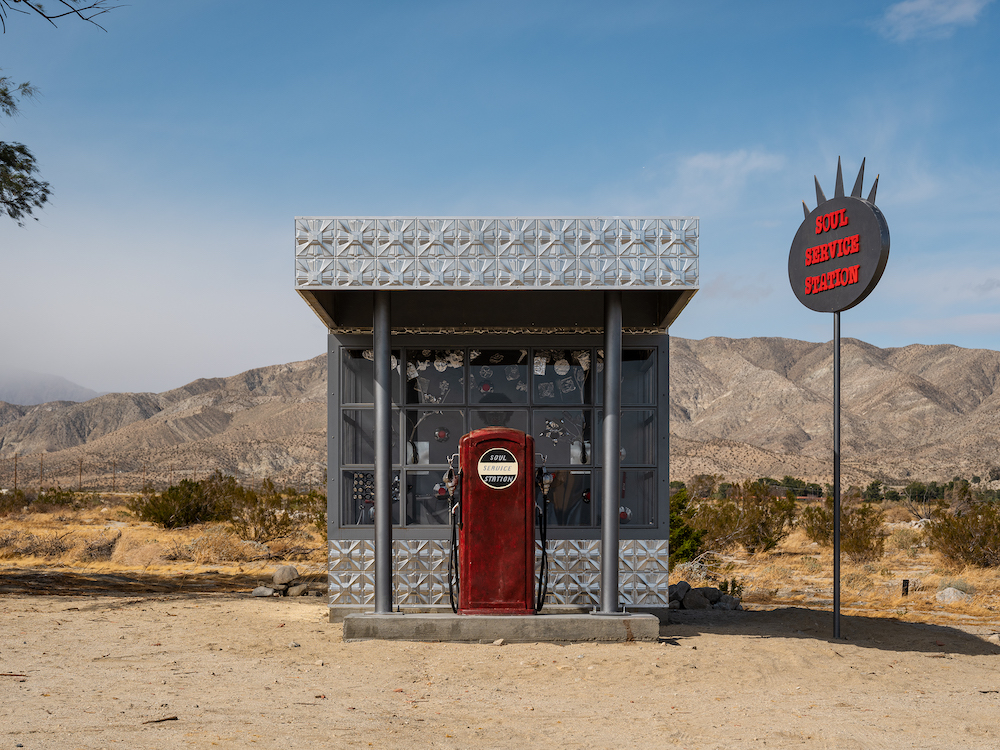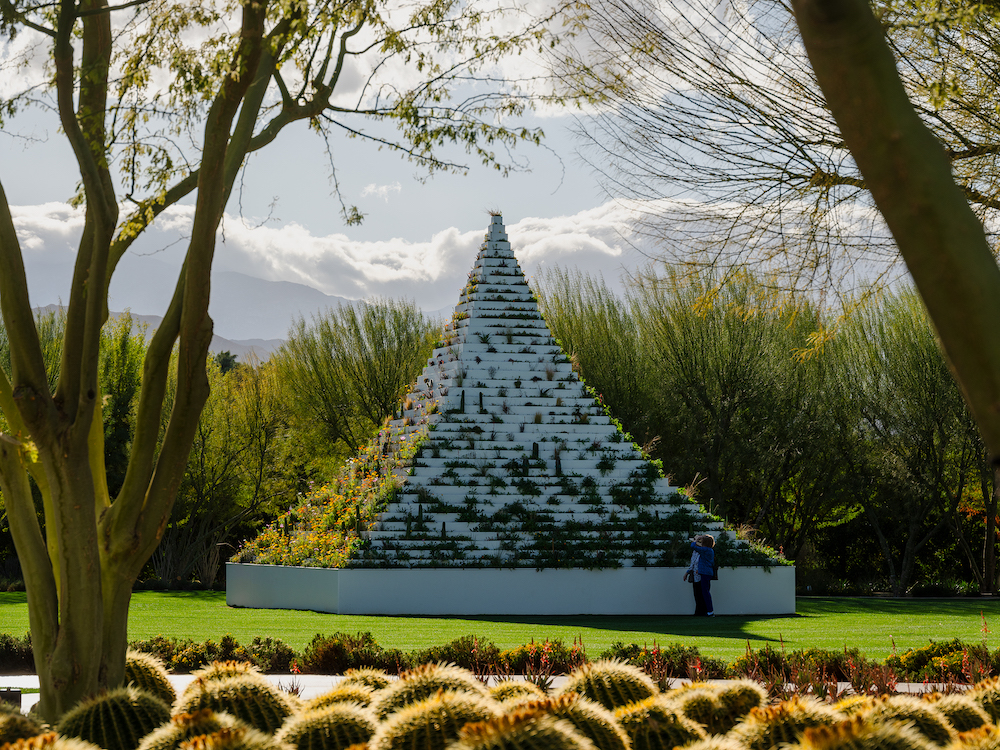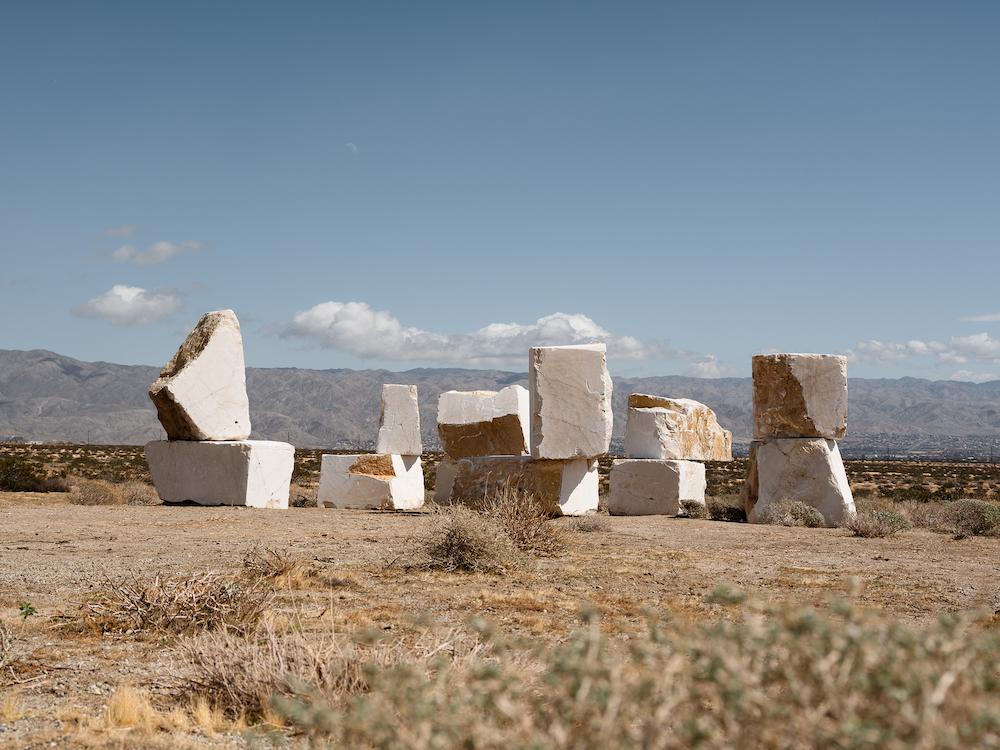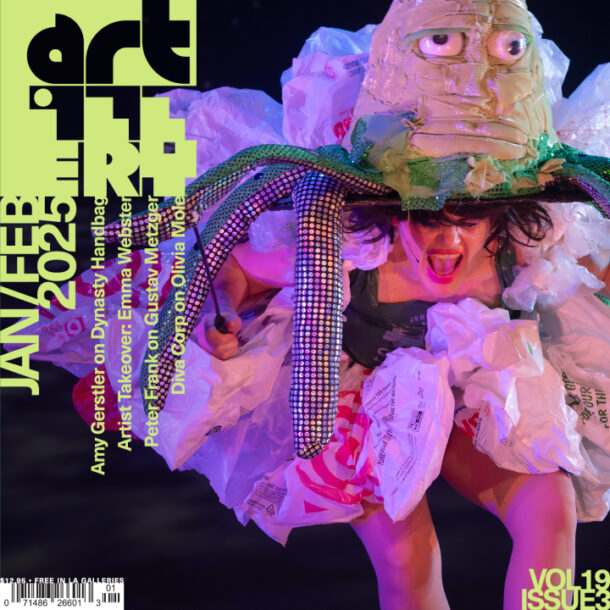Since 2017, I have been among the 1.7 million people who have participated in the art biennial-cum-treasure hunt to seek out large-scale, site-specific contemporary art installations scattered throughout the Coachella Valley desert, the land of the haves and have-nots. Not in a white cube, locked away in a walled institution, or behind a paywall, Desert X is a great equalizer, breaking down the walls of the institution and sharing the cultural wealth of art and the wild west with any who wish to seek it out.
Nestled into the perimeter of the iconic wind farms in Desert Hot Springs, Jose Dávila has installed 12 massive blocks of white marble from a Mexican quarry. Harnessing the illusion of exhilarating precarity, he balances pairs of them upon one another, creating towers and cantilevers of brilliant stone that absorb and bounce the desert sunlight, jutting into your field of vision from every perspective. The monumental presence of these unmissable forms of extracted land provokes a consideration of the counterbalanced emptiness that must exist elsewhere, mirroring the heavy weight of the lived reality of so many immigrant communities in the area but not from the area. The act of being together is beautiful, bold, and somber to behold all at once
In Palm Springs, Ronald Rael’s Adobe Oasis imagines a future where robotics and ancient adobe architecture can effectively answer the housing crisis. His open-air, maze-like structure—meant to evoke the texture of the city’s eponymous palm tree trunks—demonstrates the possibilities of a modern adobe tradition 3D printed in locally sourced and sustainable Corona Clay. I wasn’t delighted by its aesthetic—its walls looked to me more like excrement squeezed through a large icing pipe—but the imaginative underpinnings of the alternative future it proposes won me over. As they say, the future is now. The work provokes critical consideration as entire cities devastated by natural disasters are rethinking how to rebuild in a climate crisis. Rael’s installation reminds us that adobe architecture has stood the test of time and offers a glimmer of hope.

Desert X 2025 installation view of Alison Saar, Soul Service Station. Photo: Lance Gerber. Courtesy of Desert X.
I was soothed and amused by the imagined architecture of Alison Saar’s Soul Service Station, a gas station for collective healing. Like a friend who acknowledges our troubles and reminds us that we are stronger than any moment of seeming defeat, all who encounter it are invited to refill our troubled, deflated souls with optimistic energy. Its attendant, Ruby, is fashioned in Saar’s signature figurative style, carved from sturdy wood and covered in an armor of salvaged ceiling tin. I felt her protective energy washing over me as words of encouragement by poet Harryette Mullen poured out of the gas pump’s two conch shell-shaped nozzles. The experience felt like a warm hug, gently asking me to slow down and absorb the multitudes of Saar’s layered assemblage sculpture, radiating with the inherent magic of reclaimed materials that carry their own histories of resilience.
Agnes Denes’ The Living Pyramid at the historic Sunnylands Center & Gardens is a durational work covered with flora planted last November. The multi-story living sculpture, a brilliant white stepped pyramid garden bed, is a commanding centerpiece of the already impressively manicured gardens. When I visited it during the press preview in early March, set against the distant snow-covered mountaintops, the sculpture was covered in plants boasting the vibrant greens, pinks, yellows, and oranges of early spring. But everyone who visits will have a different experience as the plants continue to bloom over the course of the installation. When the snow inevitably melts, and the pyramid is in full bloom, the relationship to its site will change, and the aesthetic harmony I experienced will be replaced by the juxtaposition of a fragile garden thriving in the heart of the desert.

Desert X 2025 installation view of Agnes Denes The Living Pyramid at Sunnylands Center & Gardens. Photo: Lance Gerber. Courtesy of Desert X.
The impact of Saudi artist Muhannad Shono’s immersive installation What Remains, more so than any other project this year, doesn’t translate to 2D. Images of the work meant to pique my interest enough to pull me out into the middle of Thousand Palms seemed to promise little more than large trash bags blowing in the wind, and the artwork’s highfalutin didactic promising “a state of tremor,” had me rolling my eyes. But my experience of this anti-monument demanded quiet contemplation as I stood observing a field of —yes, rolls of trash bag-like material painted and covered in sand—malleable forms taking on the undulations and palette of the barren landscape. With only the sounds of its fabric scratching against dry desert brush in the wind breaking the silence, it felt eerily like I was at the end of the world, in a future when the last of us who had survived in tents were no longer around to maintain any semblance of home. Is this what is destined to become of us? Is this a fixed destiny, or something that can be interrupted? Is there justice and beauty in ruin? I reluctantly left after 30 minutes of observing the work as it transformed with every breeze, moving through it in quiet contemplation as my perspective of the landscape and possible answers to my existential questions changed with every step.
In today’s world of rapidly accumulating crises, I suppose it’s no surprise these installations captured my heart with their abstracted pedagogies of hope, a welcome reward for finding where X marked the spot.
Desert X 2025
Coachella Valley, California
On view through May 11, 2025


